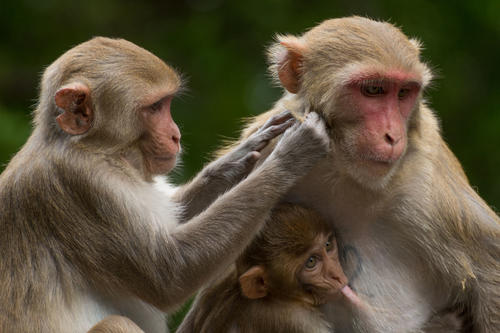Researchers develop a new method for detecting hidden genetic relationships in animal populations
News from Jan 21, 2025
Understanding biological relationships is often critical when studying animal populations. Researchers from the Max Planck Institute for Evolutionary Anthropology, Leipzig University, the German Centre for Integrative Biodiversity Research (iDiv), and Freie Universität Berlin have now developed a transformative approach that identifies identical stretches of DNA that two individuals have inherited from a common ancestor. In a new study, published in the scientific journal PNAS (Proceedings of the National Academy of Sciences of the United States of America), the team demonstrates how they successfully applied their new method to a free-ranging population of rhesus macaques. The results show that even for low-quality sequencing data, this method can accurately determine relatedness among pairs of individuals, even without prior knowledge of pedigrees within the population. This breakthrough will help to reveal previously unknown pairs of relatives and provide rich insights into the structure of wild populations of animals.
Quantifying which individuals share genetic material from common ancestors plays a central role in several scientific disciplines, particularly in the fields of animal behavior, conservation biology, and genetic evolution. While scientists initially relied on family trees (or “pedigrees”) to represent these relationships in pairs, the inherent limitations of this method prompted the search for more accurate techniques.
Recent technological advances have greatly accelerated this development. For example, genetic testing and the analysis of genetic markers called single nucleotide polymorphisms (SNPs), which represent individual variations in DNA sequence data, can help researchers infer biological relatedness.
Powerful New Genetic Tool Identifies Pairs of Relatives
An international team of researchers has now developed a software pipeline that breaks new ground in estimating genetic relatedness in animal populations. The software analyzes whole-genome sequencing data and works accurately even with very low-quality data. “Our computational tool has opened the door to a more refined understanding of genetic relationships in ecology and evolution. It accurately identifies identical DNA fragments in pairs of individuals that were inherited from a common ancestor. These identity-by-descent (IBD) segments are an exceptionally powerful signal for detecting and quantifying biological relatedness that was previously only accessible in high-quality human data. Now we can do it in animal genomes, too.” says Dr. Harald Ringbauer (Max Planck Institute for Evolutionary Anthropology), one of the senior authors of the study.
Variation in Actual Relatedness in a Macaque Population
In developing and evaluating this tool, the team ran computational experiments on a free-ranging rhesus macaque population from Cayo Santiago in Puerto Rico. The new tool delivered exceptional results compared to previous methods: While conventional methods estimate relatedness in discrete categories, this method was able to precisely represent the continuous nature of relatedness. In addition, the team detected a higher level of shared genetic inheritance than expected, suggesting the presence of previously undetected relatives within the population. “Through its application in a free-ranging primate population, our IBD method has proven its potential by providing more detailed insights into relatedness structures than traditional pedigrees or older genetic estimates,” says Annika Freudiger (Leipzig University and the Max Planck Institute for Evolutionary Anthropology), first author of the study. “This work will pave the way for further insightful studies on relatedness in natural populations and genetic biodiversity,” adds Professor Katja Nowick, human biologist at Freie Universität Berlin and another of the three senior authors of the publication. Dr. Vladimir Jovanovic from the Institute of Biology at Freie Universität Berlin also made a significant contribution to the study as a bioinformatician.
The researchers also identified discrepancies between actual genetic inheritance and the levels of inheritance predicted by pedigrees. These discrepancies indicate that pedigrees underestimated shared ancestry due to incomplete knowledge of familial relationships. They also identified significant differences in genetic recombination rates between the sexes, which could reveal the sex of unknown ancestors and thus indicate whether pairs of individuals are related through the maternal or paternal line.
Collecting Data at Cayo Santiago
The research was conducted on Cayo Santiago, a small island off the coast of Puerto Rico managed by the Caribbean Primate Research Center. The consistent collection of demographic and genetic data since 1956 allowed the researchers to test this new method in a free-ranging population and compare it with decades’ worth of extensive pedigree data. This has provided new insights into this study population. Despite the prolonged genetic isolation of the rhesus macaque population, the levels of inbreeding are surprisingly low, likely due to sex-biased dispersal and/or effective kin recognition among the macaques.
“This innovative tool enables us to accurately measure the continuous distribution of relatedness in animal populations, even from relatively low-quality sequencing data. This could lead to a significant change in our understanding of ecological and evolutionary patterns in social animals,” concludes senior author Professor Anja Widdig (Leipzig University and the Max Planck Institute for Evolutionary Anthropology). This research underscores the potential of using advanced methodologies to further our understanding of biological relatedness across species and populations and will lead to a greater understanding of family structures and preferential behaviors in the future.
This text is based on a press release published by the Max Planck Institute for Evolutionary Anthropology in Leipzig.
Further Information
Publication
Freudiger, A., V. M. Jovanovic, Y. Huang, et al. 2025. “Estimating Realized Relatedness in Free-Ranging Macaques by Inferring Identity-by-Descent Segments.” Proceedings of the National Academy of Sciences of the United States of America 122 (3): e2401106122. https://doi.org/10.1073/pnas.2401106122.
Contact
Prof. Dr. Katja Nowick, Institute of Biology, Freie Universität Berlin, Email: katja.nowick@fu-berlin.de
